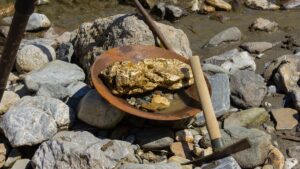Ground Breakers: When will runaway coal prices get back on the leash?

Pic: Alexei TM/iStock via Getty Images
- Westpac expects coal prices to fall back over 2022 and 2023
- But Russian coal situation and gas prices could present upside for the surprise commodity winner of 2022
- Red 5 gets ready to pour gold at King of the Hills redevelopment
The coal price has been like a runaway train from the middle of 2021 onwards, with supply disruptions, Indonesian export bans and Russia’s war with Ukraine fuelling an extraordinary imbalance between supply and demand.
Much of this has been an unusual confluence of short-term issues like rail problems in Russia and South Africa, wet weather and Covid absenteeism in Australia and elsewhere and labour disputes in Colombia.
But much has come from the structural underinvestment in new mined supplies for both thermal and metallurgical coal, something touched on by Coronado (ASX:CRN) boss Gerry Spindler earlier this week as he announced the first of what will likely be many large dividend payments under a new policy following its return to major profitability.
Westpac senior economist Justin Smirk assessed Australian hard coking coal at US$482/t on May 5 and thermal coal at US$337/t. Prices have risen in spot markets since then.
“Thermal (Newcastle) coal prices are up 36% since the 24th February when Russia invaded Ukraine, while Qld met coal is up 18% with both reaching all-time highs due to record high gas prices resulting from the ongoing disruptions to Russian supply,” Smirk said in a report.
“In addition, Western sanctions are making it difficult to trade Russian coal. Russia produced around 430mt of coal in 2021 and exported around 210mt to make it the third largest exporter of seaborne thermal coal (~160mt or 15% of exports) and the second largest exporter of met-coal (~50mt or 13% of exports).”
He sees a correction coming before the end of the year, with thermal coal dropping to US$250/t and met coal down to US$355/t, with those prices moderating further to US$149/t for Newcastle thermal coal and US$250/t for met coal at the end of 2023 (still prices coal miners would happily accept in historical terms).
That is partly predicated on the idea unusual supply disruptions have been at play for the recent record run.
“The recent surge in prices has resulted from a shortage in seaborne coal, supply is down 6% year to date despite record high prices, with the industry struggling to lift output due to weather and COVID disruptions adding to the ongoing labour shortages and years of underinvestment,” Smirk said.
“In addition, Russian coal shipments (mainly from the Far East) are down around 11% year to date.”
Upside could still exist
Incredibly though, upside could still be there. Prices remain high even though China has retreated from the seaborne market by ramping up domestic production by a planned 300Mt this year.
Gas prices remain extremely high, fostering switching to coal with gas currently 45% more expensive for power generation than thermal coal.
“It has been estimated that the current API2 coal price break-even with the current EU gas price is US$572/t. The second is further disruptions to Russian supplies of coal,” Smirk says.
“Finding an alternative to 50 to 100Mt of Russian coal is significantly more challenging than other commodities due to logistical constraints and quality differences.”
While much has been made of the ability of Russia to flip its coal flows to China, it will also take 2-3 years for the Russian Government to complete a $10 billion eastbound rail upgrade to make cargo increases viable.
Red 5 on cusp of first gold pour at King of the Hills
Materials stocks have enjoyed a mixed open to the day.
Some positives came from a drop in reported Covid infections in Shanghai, with higher copper prices propelling copper producer 29Metals (ASX:29M) to a 2.88% gain.
While news is sparse among the majors in these post-reporting season times, emerging gold miner Red 5 (ASX:RED) did deliver an update on the start of processing at its King of the Hills mine near Leonora in WA.
RED has spent upwards of $200 million redeveloping the open pit at KoTH left behind after the collapse of Sons of Gwalia in the early 2000s.
It now boasts a 2.4Moz reserve and 16-year mine life, with the start of processing of low grade ore at its new mill laying the groundwork for a maiden gold pour in the near future.
Red 5 boss Mark Williams said the start of processing “on time and budget” was a key milestone for the mid-tier aspirant.
“The King of the Hills processing plant will become a highly efficient processing hub for our operations in the Leonora district, enabling Red 5 to deliver a significant step-change in our business,” he said.
Red 5 (ASX:RED) share price today:
Related Topics

UNLOCK INSIGHTS
Discover the untold stories of emerging ASX stocks.
Daily news and expert analysis, it's free to subscribe.
By proceeding, you confirm you understand that we handle personal information in accordance with our Privacy Policy.








